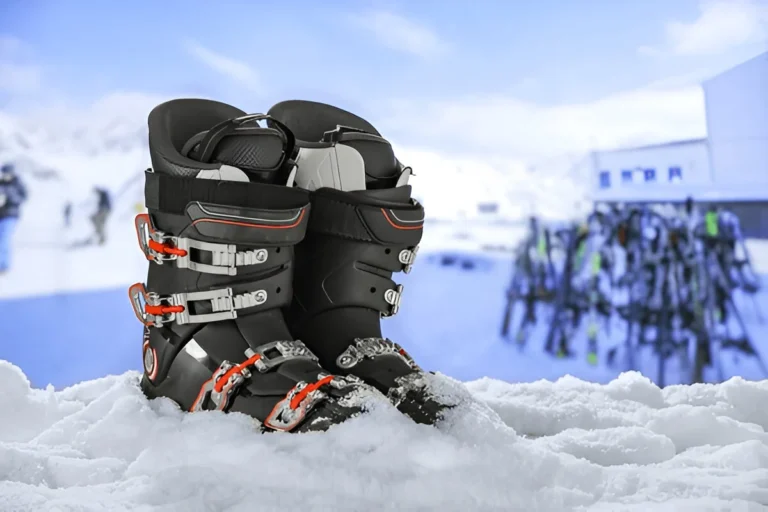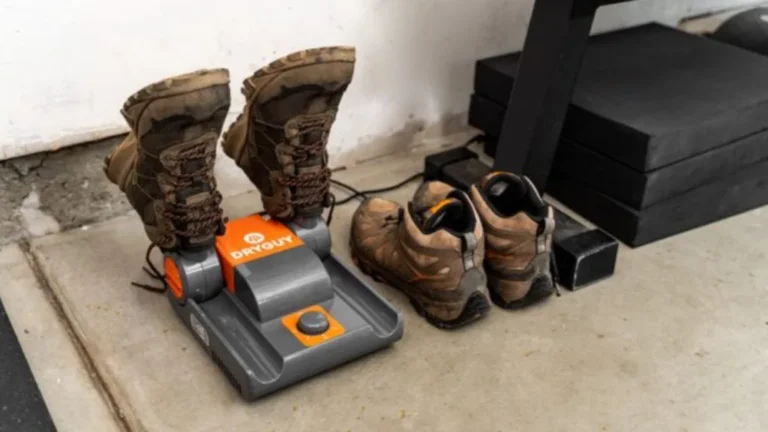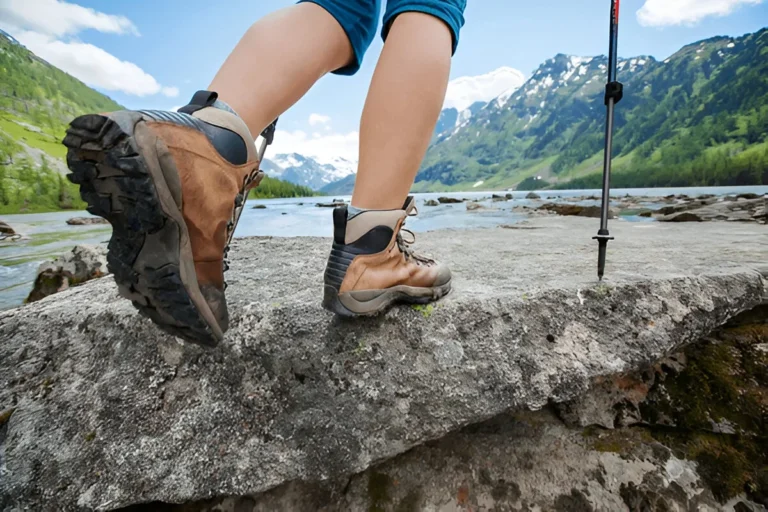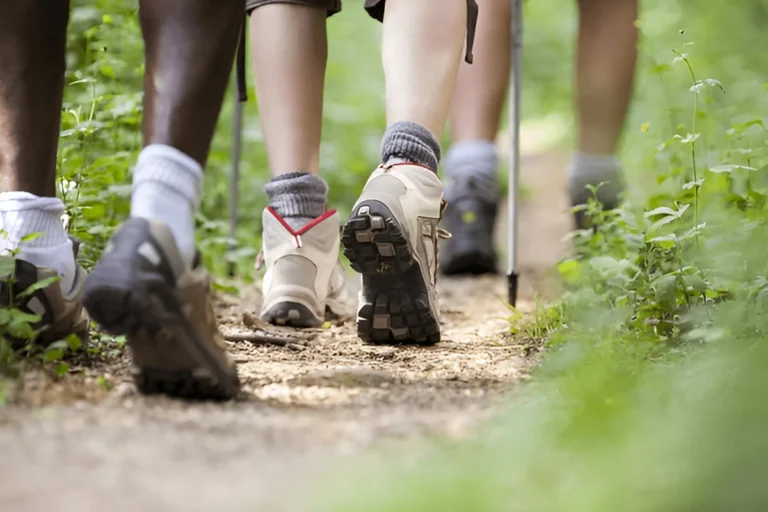Finding the best hiking boots for men is not only about style. It is also about comfort and safety on the trail. A good pair of boots can protect your feet from rocks and water. It can also stop blisters and ankle pain. If you choose the right boots, you can enjoy every mile of your hike without worry.
We tested more than 50 different hiking boots in real outdoor conditions. Our team walked on rocky paths. We climbed mountains. We crossed muddy trails and wet streams. Every boot was checked for comfort, durability, traction, water resistance, and weight. This helped us to see which boots are good for daily hikes and which are strong enough for extreme trips.
From all the products we tested, only a few gave the best results. The NORTIV 8 Men’s Insulated Waterproof Boots are our top pick for overall performance. The Merrell Moab 3 Mid Waterproof is the best choice for hikers who want a budget-friendly boot. The Salomon Quest 4 Gore Tex is great for long backpacking trips because it gives very strong support. For mountain climbing, the Scarpa Zodiac Plus GTX works best. The La Sportiva Ultra Raptor II Mid GTX is perfect for fast-moving hikers. If you need extra space for wide feet, the KEEN Targhee IV WP is a reliable option. For a lighter option, visit our men’s hiking shoe review, which offers great alternatives to full boots.
These nine hiking boots are the best in 2025. Each one has been tested in real-life conditions, so you can trust that they will keep you safe and comfortable on the trail. Whether you are hiking for fun or planning a tough mountain climb, this list has a pair that will work for you.
Top Best Hiking Boots for Men Review
When it comes to hiking footwear, no single boot is perfect for every hiker. Some people need a strong, supportive boot for mountain climbs, while others want a light and comfortable boot for short weekend trails. In 2025, the best hiking boots bring together comfort, traction, durability, water protection, and the right fit for your adventure. Our top overall pick is the NORTIV 8 Men’s Insulated Waterproof Boots, which give a balance of comfort and toughness. Looking for something more affordable, the Merrell Moab 3 Mid Waterproof offers reliable performance without a high price.
Hikers who need strong ankle support can trust the Salomon Quest 4 Gore Tex, while climbers can choose the Scarpa Zodiac Plus GTX for tough mountain routes. For fast hiking and mixed trails, the La Sportiva Ultra Raptor II Mid GTX is an excellent synthetic option. Wide-foot hikers will find comfort in the KEEN Targhee IV WP. If you want light cushioning for day hikes, the KEEN Hightrail Mid is a great choice. For maximum waterproofing, the La Sportiva Nucleo High II GTX offers outstanding protection in wet conditions.
1. Best Overall Hiking Boot – NORTIV 8 Men’s Insulated Waterproof Construction Hiking Boots
Specifications
- Material: Synthetic leather and textile with waterproof coating
- Insulation: Padded warm lining for cold weather
- Outsole: Rubber sole with multi-directional traction lugs
- Support: Mid-cut ankle support with padded collar
- Fit: Standard men’s sizing with a roomy toe box
- Weather Protection: Water-resistant and insulated for wet and cool conditions
- Best Use: Day hikes, casual backpacking, wet and muddy trails
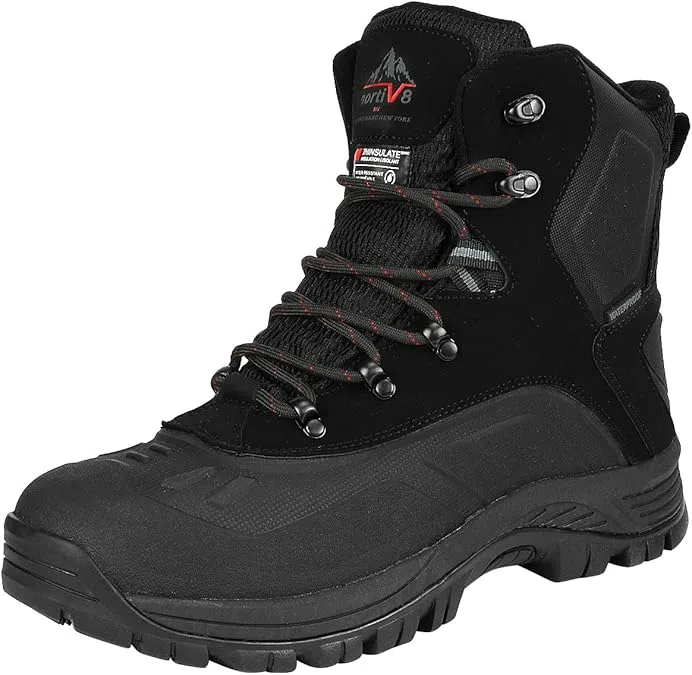
The NORTIV 8 Men’s Insulated Waterproof Hiking Boots are designed for hikers who require robust performance in various outdoor conditions. Some light trail shoes can wear out fast, but these boots focus on strength and long life. The upper uses synthetic leather and textile with a waterproof layer. This lets you step through puddles, muddy paths, or even light snow without getting wet feet. The padded insulation keeps warmth inside, making these boots useful in cold weather or early morning hikes when the ground feels damp and chilly.
REASONS TO BUY
- Comfortable fit with good ankle support
- Waterproof construction keeps feet dry
- Warm lining works well in cool and wet weather
- Reinforced toe cap for added protection
- Excellent value for money
REASONS TO AVOID
- Waterproofing may fade with heavy use
- Less breathable in hot weather
Comfort is another strength of the NORTIV 8. The mid-cut design gives steady ankle support and lowers the risk of twists or tired legs on rough trails. Inside the boots, you find a cushioned lining that feels soft from the first wear. Many hikers say they do not need a long break-in period, which is good if you want to start hiking right after buying them. The strong toe cap also gives extra safety against rocks and roots, which is important on hard ground.
On the trail, the rubber sole gives good grip on dirt paths, rocky climbs, and forest tracks. The tread has many small lugs that help with grip on different surfaces. Like most budget-friendly boots, they work best on dry or slightly wet ground and are not made for ice. Overall, the NORTIV 8 gives a good mix of comfort, support, and price. They are a great all-around choice if you want one pair of boots that can handle many adventures without costing too much.
2. Best Budget Hiking Boots – Merrell Moab 3 Mid Waterproof
Specifications
- Material: Suede leather and mesh upper with a waterproof membrane
- Insulation: Lightweight mesh lining for breathability
- Outsole: Vibram TC5+ rubber with deep traction lugs
- Support: Mid cut with molded nylon arch shank
- Fit: Standard sizing with wide options available
- Weather Protection: Waterproof but breathable design
- Best Use: Day hikes, light backpacking, wet and muddy trails

The Merrell Moab 3 Mid Waterproof is one of the most popular choices for hikers who want quality boots at a fair price. Known as the Mother of All Boots, the Moab series has been trusted for years on trails all over the world. This updated version keeps the same comfort and dependability while adding small improvements in cushioning and outsole design.
REASONS TO BUY
- Very comfortable from first wear
- Affordable price with strong value
- Good traction on most trail types
- Waterproof yet breathable
REASONS TO AVOID
- Not warm enough for freezing weather
- Less ankle support than heavy boots
These boots feel comfortable right out of the box, which makes them perfect for beginners or casual hikers. The mid-cut design gives light ankle support, and the Vibram outsole provides good grip on dirt, gravel, and rocky paths. The waterproof membrane keeps your feet dry in rain or mud, and the breathable mesh lining helps reduce sweat during warmer hikes. For the price, the Moab 3 offers a very good balance of comfort, traction, and protection.
If you hike mostly on regular trails and want something simple and reliable, the Merrell Moab 3 Mid Waterproof is an easy choice. They may not be the best for very cold or steep mountain climbs, but for day hikes and weekend trips, they deliver excellent value.
3. Best Support Boots – Salomon Quest 4 Gore-Tex
Specifications
- Material: Nubuck leather and textile with Gore-Tex waterproof lining
- Insulation: Cushioned midsole for comfort, not heat-focused
- Outsole: Salomon Contagrip rubber with deep traction lugs
- Support: High ankle cut with an advanced support frame
- Fit: Regular sizing with a secure lacing system
- Weather Protection: Fully waterproof and breathable
- Best Use: Backpacking, multi-day treks, mountain hiking, rough terrain
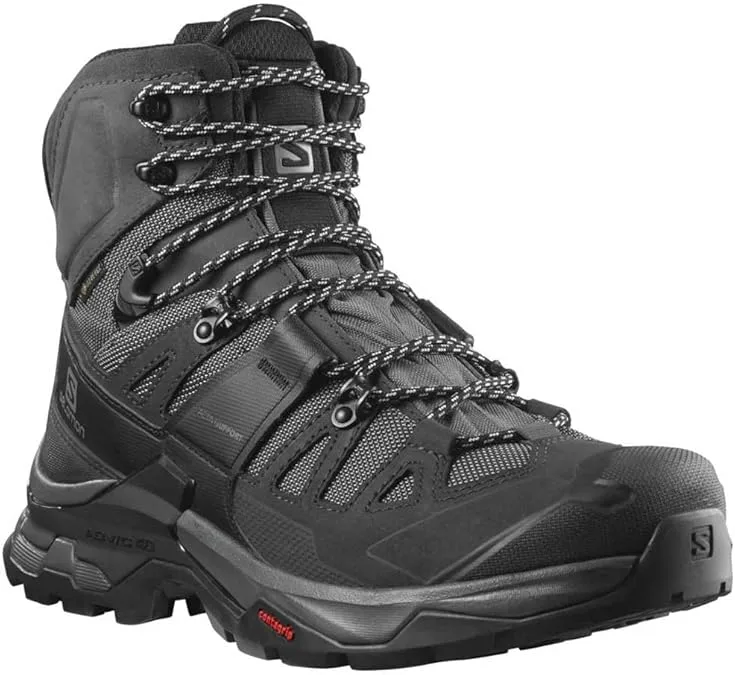
The Salomon Quest 4 Gore-Tex is designed for hikers who carry heavy packs or go on long and difficult treks. These boots are made for strength and stability, which makes them perfect for backpacking and mountain trails. The Gore-Tex lining keeps water out while still letting your feet breathe. This means you can walk in rain or wet ground without worrying about soggy socks.
REASONS TO BUY
- Excellent ankle and foot support
- Fully waterproof with breathable lining
- Strong grip on many surfaces
- Durable build for long hikes
REASONS TO AVOID
- Heavier than light trail boots
- Higher price than budget options
One of the main strengths of the Quest 4 is support. The tall ankle cut and strong frame hold your feet steady on rough ground. The cushioned midsole adds comfort on long walks and helps reduce tired legs. The Contagrip outsole is built for a strong grip on rock, dirt, and even slippery surfaces. Many hikers trust these boots for trips that last many days in changing weather.
If you want a tough boot that can handle long hikes with a heavy backpack, the Salomon Quest 4 Gore-Tex is a smart choice. It may feel heavier than a lighter trail boot, but the stability and protection make it worth it for serious hiking.
4. Best Synthetic Hiking Boots – Men’s La Sportiva Ultra Raptor II Mid GTX
Specifications
- Material: Synthetic mesh and abrasion-resistant fabric with Gore-Tex lining
- Insulation: Lightweight with breathable lining
- Outsole: FriXion XF 2.0 rubber with Impact Brake System lugs
- Support: Mid-cut ankle support, flexible build
- Fit: Slim athletic fit, true to size
- Weather Protection: Waterproof and breathable
- Best Use: Trail hiking, mixed terrain, and wet conditions
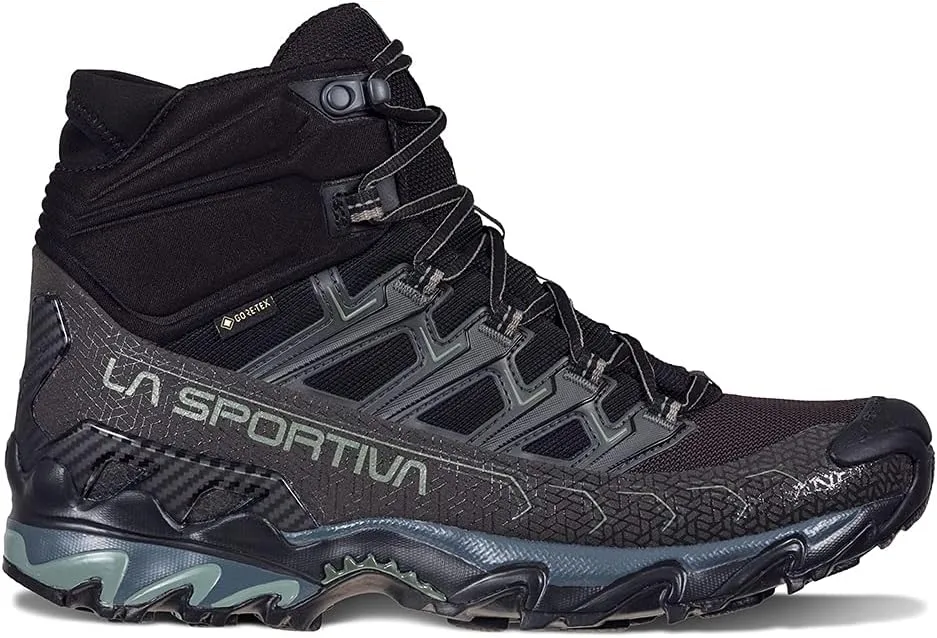
The La Sportiva Ultra Raptor II Mid GTX is a lightweight synthetic hiking boot made for hikers who want speed and comfort on the trail. It is built with Gore-Tex lining to keep your feet dry while still allowing airflow. This makes it a good choice for wet but active conditions. The design is inspired by trail running shoes, so it feels lighter and more flexible than heavy leather boots.
REASONS TO BUY
- Lightweight and flexible design
- Gore Tex waterproofing with breathability
- Strong traction on rocky and muddy ground
- Quick-drying synthetic materials
REASONS TO AVOID
- Not warm enough for cold winter hikes
- Less durable than heavy leather boots
These boots shine on mixed terrain. The mid cut provides enough ankle support without feeling bulky, and the aggressive rubber outsole grips well on rocky paths and muddy ground. The synthetic upper dries faster than leather, which is useful in rainy climates or on river crossings. Even though it is light, the boot still offers stability for carrying a pack on medium-distance hikes.
If you need a fast-moving boot that balances comfort, waterproofing, and agility, the La Sportiva Ultra Raptor II Mid GTX is an excellent option. It is not built for very cold weather or heavy alpine climbs, but for trail hiking and backpacking, it performs very well.
5. Best for Mountain Climbing – Scarpa Zodiac Plus GTX
Specifications
- Material: Suede leather upper with Gore-Tex waterproof lining
- Insulation: Moderate comfort lining not for extreme cold
- Outsole: Vibram Drumlin sole with high traction lugs
- Support: Mid to high cut ankle support, stiff sole
- Fit: Regular fit with snug hold
- Weather Protection: Fully waterproof with good breathability
- Best Use: Mountain climbing, alpine hiking, heavy pack trips
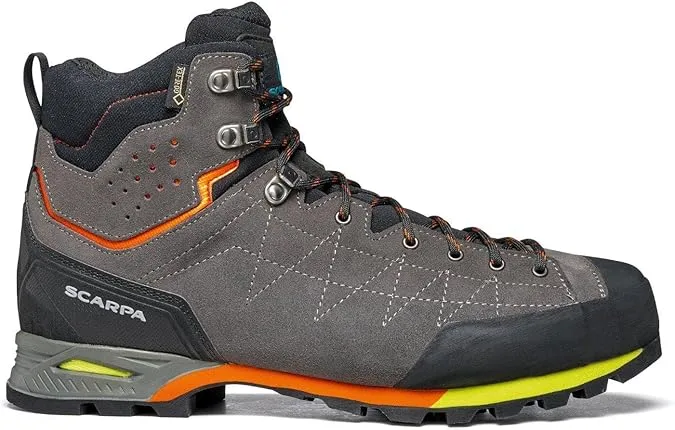
The Scarpa Zodiac Plus GTX is a boot made for serious mountain hikes and climbs. It combines the strength of a mountaineering boot with the comfort of a hiking boot. The suede leather upper is tough and resists wear from sharp rocks, while the Gore-Tex lining keeps water out even in wet alpine conditions. These boots are built for demanding terrain where support and stability are more important than light weight.
REASONS TO BUY
- Excellent grip on rock and technical ground
- Strong support for heavy packs and steep climbs
- Durable suede leather build
- Waterproof with Gore Tex lining
REASONS TO AVOID
- Heavier than regular hiking boots
- Not ideal for warm weather or light trails
One of the main features of the Zodiac Plus is its stability on steep ground. The mid-height ankle cut and stiff sole give you a solid base for carrying heavy packs or climbing rocky slopes. The Vibram outsole grips tightly on both wet and dry rock, which makes it a safe choice for technical trails. Even though the boot is strong, it still has enough cushioning to keep your feet comfortable on long days.
For hikers and climbers who plan to explore mountains or very rough terrain, the Scarpa Zodiac Plus GTX is a top choice. It may feel heavy for casual trails, but in tough alpine conditions, it provides the support and protection you need.
6. Best for Off-Trail Hiking – La Sportiva Ultra Raptor II Mid GTX
Specifications
- Material: Synthetic mesh and abrasion-resistant fabric with Gore-Tex lining
- Insulation: Lightweight lining for breathable comfort
- Outsole: FriXion XF 2.0 rubber with aggressive lugs
- Support: Mid-cut ankle with stable sole
- Fit: Athletic, snug fit, true to size
- Weather Protection: Waterproof breathable build
- Best Use: Off-trail hiking, bushwhacking, mixed terrain

The La Sportiva Ultra Raptor II Mid GTX is designed for hikers who often leave the main trail and explore rough ground. It combines the agility of a trail running shoe with the stability of a hiking boot. The synthetic upper with Gore-Tex lining keeps your feet dry in wet conditions and also dries faster than leather when exposed to water.
REASONS TO BUY
- Excellent traction on loose and rocky ground
- Lightweight yet supportive
- Gore-Tex keeps feet dry
- Quick-drying synthetic build
REASONS TO AVOID
- Not insulated for cold weather
- Less durable than heavy leather boots
This boot stands out for its grip and control. The FriXion rubber outsole with aggressive lugs holds firm on rocks, mud, and uneven ground. The mid-cut design adds ankle support without feeling too heavy. It is light enough for fast hiking but still tough enough for bushwhacking or walking across loose scree. The fit is snug and secure, which helps reduce slipping inside the boot on steep slopes.
For hikers who love adventure beyond marked trails, the Ultra Raptor II Mid GTX offers a good mix of speed, protection, and traction. It is not the warmest choice for winter use, but for three-season hiking and off-trail exploring, it is one of the best options available.
7. Best wide-fit hiking boots – Men’s KEEN Targhee IV WP
Specifications
- Material: Waterproof leather and performance mesh upper
- Insulation: Cushioned insole for comfort, not heat-focused
- Outsole: KEEN all-terrain rubber outsole with multi-directional lugs
- Support: Mid-cut ankle with reinforced heel
- Fit: Wide toe box with roomy design
- Weather Protection: Waterproof breathable membrane
- Best Use: Day hikes, casual backpacking, wet trails
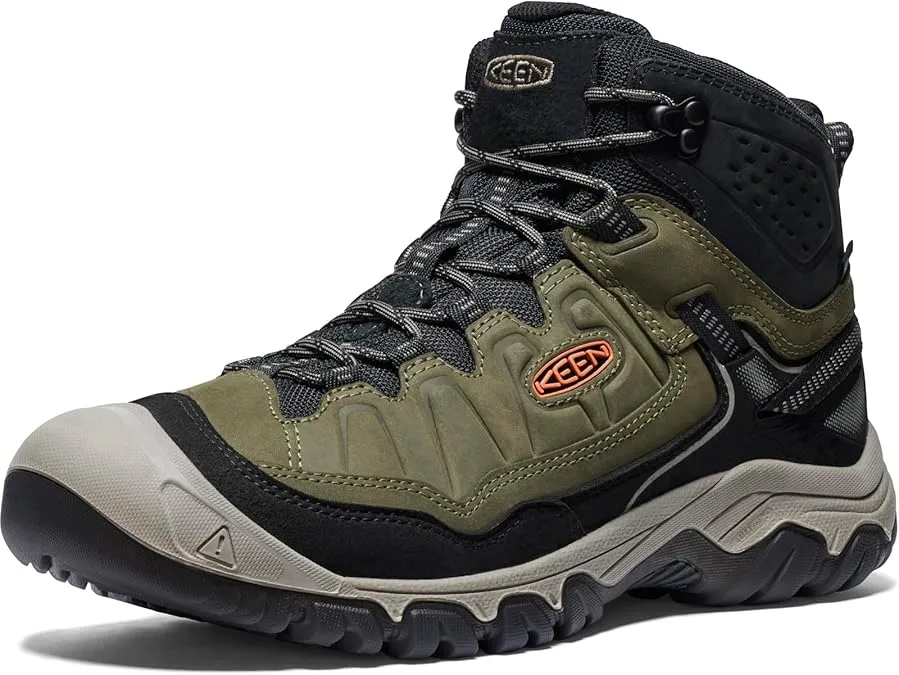
The KEEN Targhee IV WP is built for hikers who want a comfortable, wide fit without losing performance on the trail. KEEN is well known for its roomy toe box and supportive design, which makes these boots a favorite among people with broad feet. The leather and mesh upper is treated with waterproof protection so your feet stay dry in rain or muddy conditions.
REASONS TO BUY
- Wide fit with roomy toe box
- Comfortable for long hikes
- Good grip on wet and dry surfaces
- Durable leather and mesh build
REASONS TO AVOID
- Heavier than light trail boots
- Not very breathable in hot weather
These boots give a good balance between comfort and strength. The mid-cut design offers steady ankle support while the cushioned insole keeps your steps soft on long hikes. The KEEN all-terrain rubber outsole grips well on dirt paths, rocks, and wet ground. Even after hours of hiking, the roomy fit reduces pressure on the toes, which helps prevent blisters and discomfort.
For hikers with wider feet, the KEEN Targhee IV WP is a reliable choice. It may not be as light as a trail shoe, but the comfort, durability, and fit make it one of the most trusted boots for everyday hiking.
8. Light and Plush Hiking Boot – Men’s KEEN Hightrail Mid
Specifications
- Material: Breathable mesh and synthetic upper with waterproof membrane
- Insulation: Cushioned insole with lightweight padding
- Outsole: KEEN all-terrain rubber outsole with moderate lugs
- Support: Mid-cut ankle design with soft collar
- Fit: Standard fit with focus on comfort
- Weather Protection: Waterproof breathable system
- Best Use: Day hikes, casual trails, warm weather
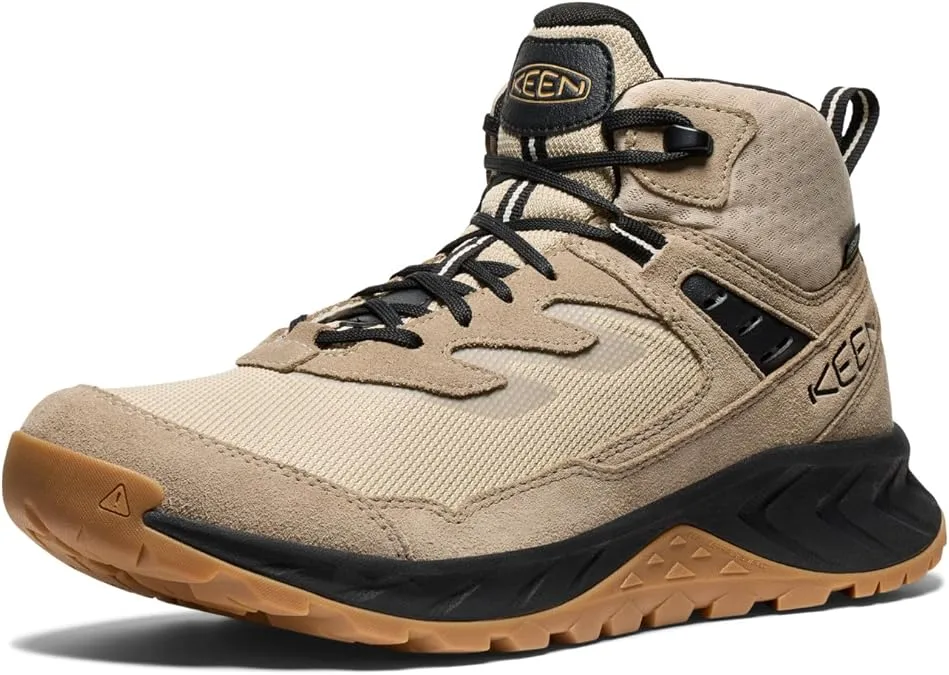
The KEEN Hightrail Mid is made for hikers who want comfort and lightweight performance on the trail. These boots feel more like cushioned sneakers but still give the ankle support of a mid-cut hiking boot. The breathable mesh upper with waterproof protection keeps your feet dry while allowing airflow during warm hikes.
REASONS TO BUY
- Very lightweight and easy to wear
- Soft cushioning reduces foot fatigue
- Waterproof yet breathable
- Comfortable for casual hikers
REASONS TO AVOID
- Less durable than leather boots
- Not strong enough for alpine
These boots are great for day hikes and shorter backpacking trips. The cushioning underfoot feels soft and reduces fatigue on long walks. The KEEN all-terrain outsole provides solid grip on dirt trails and rocky paths, though it is less aggressive than heavy-duty mountain boots. With a lighter design, the Hightrail Mid is easy to wear all day without feeling bulky.
For hikers who want comfort first and do not need heavy protection, the KEEN Hightrail Mid is a good pick. It is not built for alpine climbs or very rough trails, but for casual hiking and outdoor travel; it delivers an easy and supportive experience.
9. Best Waterproof Protection – La Sportiva Nucleo High II GTX
Specifications
- Material: Nubuck leather upper with Gore Tex Surround membrane
- Insulation: Cushioned midsole for comfort
- Outsole: Vibram Nano sole with multi-directional lugs
- Support: High cut ankle support for stability
- Fit: Regular fit, snug and supportive
- Weather Protection: 100 percent waterproof and breathable
- Best Use: Wet climates, multi-day trek, backpacking
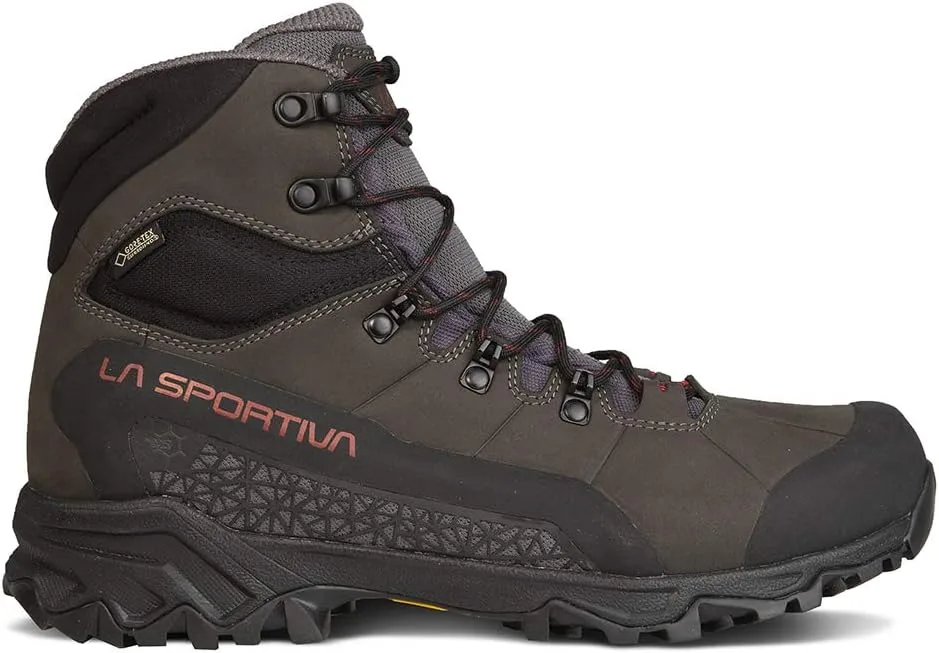
The La Sportiva Nucleo High II GTX is designed for hikers who need strong waterproofing without losing breathability. Built with Gore-Tex Surround technology, these boots keep your feet dry in heavy rain and wet trails while also allowing air to circulate. This makes them one of the best choices for humid or rainy climates where moisture is a constant problem.
REASONS TO BUY
- Excellent waterproofing with Gore Tex Surround
- Strong traction on wet and muddy trails
- Durable leather upper
- Supportive for long hikes with packs
REASONS TO AVOID
- Higher price than most boots
- Heavier than synthetic options
The boot combines durable nubuck leather with a high cut design for ankle support and long-lasting wear. The Vibram outsole provides excellent grip on muddy trails, wet rocks, and loose gravel. Inside the cushioned midsole offers comfort for long days of walking while still keeping the boot stable under heavy loads. Many hikers choose the Nucleo High II GTX for multi-day trips where changing weather is common.
For those who want maximum waterproofing with dependable traction, the La Sportiva Nucleo High II GTX is a premium option. It is not the lightest boot on the list, and it comes at a higher price, but the durability and protection make it worth the investment for serious hikers.
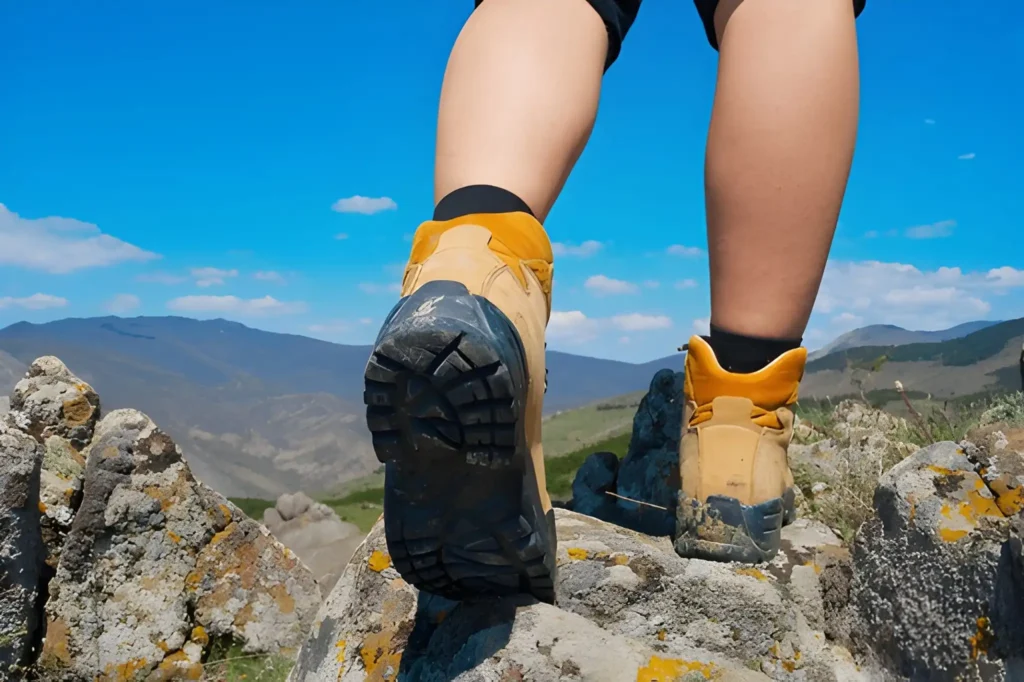
How We Tested the Best Hiking Boots for Men
To make sure our reviews are fair and useful, we tested each pair of hiking boots in real outdoor conditions. Our team wore them on muddy trails, rocky climbs, forest paths, and wet crossings to see how they performed in different situations. Every boot was judged on five main factors. Comfort to check how the boots feel during short and long hikes. Durability to see how well the materials hold up against rocks, dirt, and repeated use. Traction to measure grip on dry and slippery ground. Weight to balance strength with ease of movement. And Water Resistance to confirm if the boots can keep feet dry in rain puddles and wet grass. By focusing on these five points, we were able to select only the boots that truly work well for hikers of all levels.
We rate hiking boots on five performance metrics:
- Comfort
- Durability
- Traction
- Weight
- Water Resistance
Performance Analysis and Test Results:
Comfort
Comfort is the first thing most hikers notice, and it can decide whether a hike is enjoyable or painful. A comfortable boot should give a natural fit that supports the foot without causing pressure or rubbing. We tested how each model felt during short trail walks and long multi-hour hikes. Boots with good cushioning and well-shaped ankle collars reduced fatigue and kept our testers moving without soreness. Poorly fitted boots caused hot spots, blisters, or pinching, especially when worn with heavy packs.
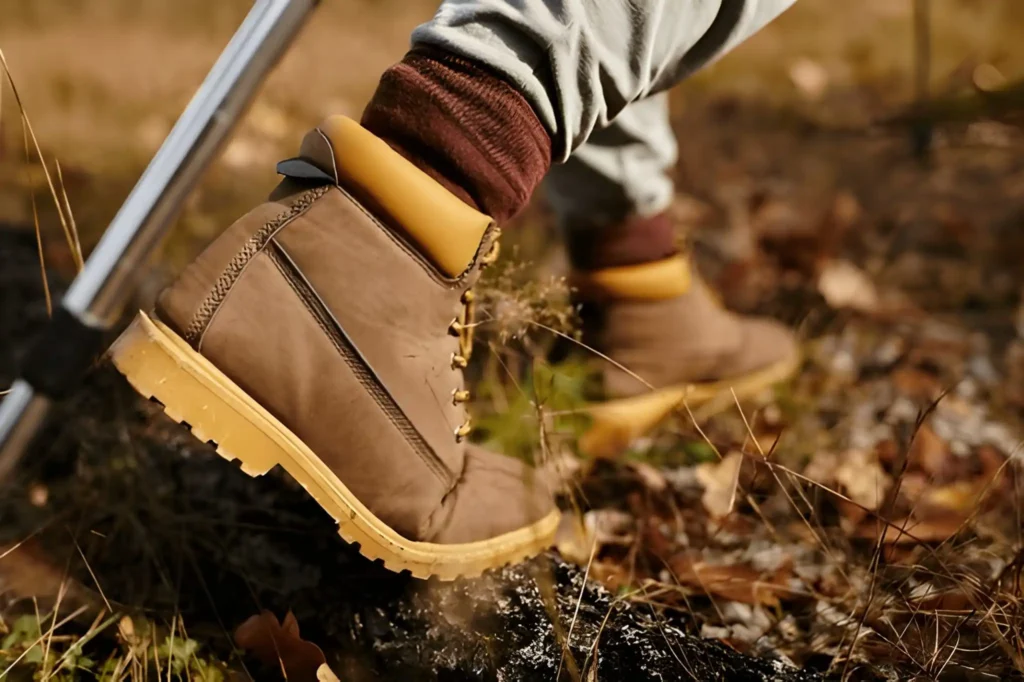
Footbed Feel
The footbed plays a big role in how the boot feels underfoot. A quality footbed absorbs shock from rocks and roots and spreads pressure evenly across the foot. Some boots came with removable insoles that could be upgraded with custom orthotics for extra support. Boots with stiff or thin footbeds felt harder on rough ground and caused quicker foot strain.
Lacing System
A secure lacing system can completely change the fit of a hiking boot. We looked at how easy it was to tighten and adjust the laces and how well the boots held that fit during long hikes. Good systems with metal eyelets and smooth lace movement kept the heel locked in place and reduced sliding. Boots with weaker laces or shallow eyelets often loosen during use, which lowers ankle stability on steep terrain.
Breathability
Hiking often means long hours on the trail in changing weather. Breathability helps prevent sweat buildup, which can lead to blisters. We tested each boot in both warm and cool conditions. Synthetic uppers with mesh panels allowed airflow and kept feet cooler on hot days. Leather boots gave less ventilation but provided more warmth in cold weather. Finding the right balance of breathability depends on whether you hike mostly in warm or cold climates.
Traction
Strong traction is critical for safety. We tested grip on dry dirt paths, loose gravel, wet rocks, and muddy slopes. Vibram soles with deep lugs performed best by holding firm in nearly all conditions. Some budget boots had shallower lugs, which worked fine on packed trails but slipped on slick ground. A boot with good traction gave hikers more confidence to walk faster and tackle harder routes without fear of slipping.
Water Resistance
We tested water resistance by walking through puddles, wet grass, and rainy trails. Boots with Gore Tex linings kept feet fully dry even after hours of exposure. Others with simple water-resistant coatings only blocked light moisture before water started to seep in. Waterproofing is vital for hikes in wet climates or multi-day trips where dry feet can prevent blisters and keep you comfortable.
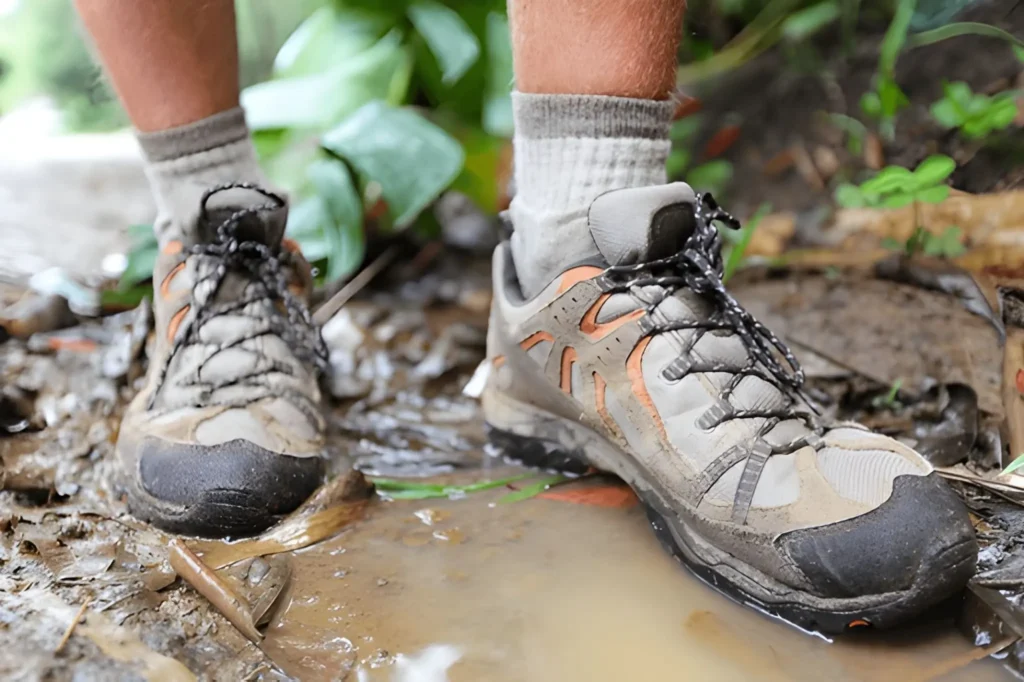
Weight
Weight matters more than many think. A heavy boot can feel safe at first, but after hours of walking, it makes legs tired more quickly. Lightweight boots are easier for fast-paced hiking but sometimes trade off ankle support and durability. We compared how heavy each pair felt on long hikes and how the balance of weight to stability matched different types of terrain. For casual day hikes, lighter boots worked best, but for mountain treks, heavier models provided the support needed for carrying packs.
Durability
Durability shows how long a boot will last after repeated use. We checked stitching seams, outsole wear, and upper material after days of testing. Leather boots were the most durable, handling scrapes and rocks without damage. Synthetic boots were lighter and dried faster, but showed wear earlier around the sole and upper connection. A durable boot is worth the investment if you hike often or cover rough terrain.
How to Choose Hiking Boots for Men
SIZING
Getting the right size is the most important step when choosing hiking boots. A boot that is too small will cause blisters and black toenails on downhill trails. A boot that is too big will let your foot slide around and create painful hot spots. Always try boots on with the socks you plan to hike in. Make sure there is enough room in the toe box to wiggle your toes, but not so much that your foot moves too much inside the boot. A good fit should lock your heel in place and give steady support to your ankle. Many brands also offer wide sizes, which are better for hikers with broad feet.
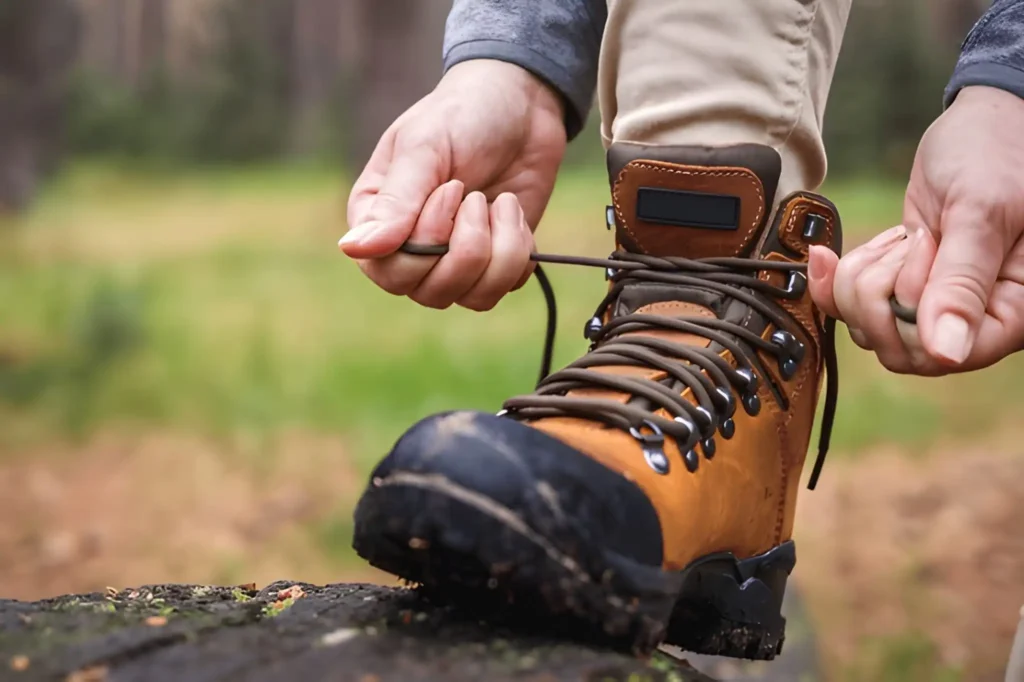
TRACTION
Traction is what keeps you from slipping on mud, loose gravel, or wet rocks. A boot with deep lugs and a strong rubber sole grips the ground better and gives you more confidence on the trail. Vibram soles are a trusted choice for many hikers because they are designed for all kinds of surfaces. When choosing boots, think about where you hike most often. If you walk mostly on dry trails, you may not need heavy lugs, but if you hike in rain or steep mountains, strong traction is very important.
INSOLES
The insole is the part inside the boot where your foot rests. A good insole should give arch support and cushioning to reduce foot pain. Many boots come with standard insoles that work fine for short hikes, but serious hikers often replace them with custom or high-quality insoles for more comfort. Insoles can also help if you have flat feet, high arches, or other foot problems. Choosing the right insole makes a big difference on long trips.
SOCKS
Socks are often forgotten, but they play a big role in hiking comfort. Thick cotton socks hold moisture and can cause blisters, so they should be avoided. Merino wool or synthetic hiking socks are the best choice. They pull sweat away from your skin, keep your feet dry, and add extra cushioning inside the boot. A good pair of socks can make an average boot feel much more comfortable.
MANAGING MOISTURE & BLISTERS
Moisture is the main cause of blisters. Even the best boots will cause problems if your feet stay wet. Waterproof boots with breathable membranes help, but you should also change socks on long hikes and air out your feet during breaks. Blister prevention tape or balm can protect common hot spots like the heel or toes. If a blister does form, keep it clean, dry, and covered so it heals faster. Managing moisture is the key to keeping your feet healthy on the trail.
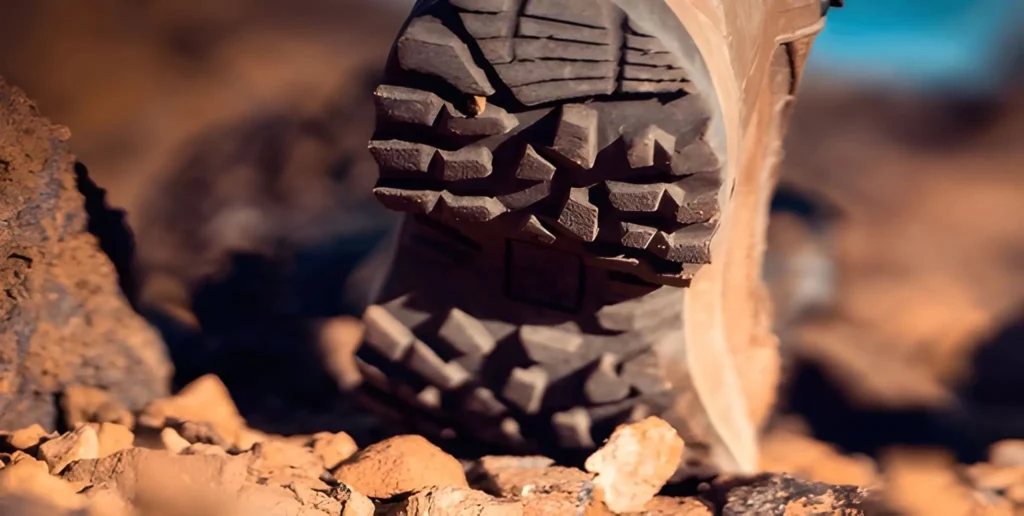
Why Trust Outdoor Searcher
At Outdoor Searcher, our goal is to give honest and experience-based reviews that help hikers make the right choice. We do not just look at product labels or brand names. Every boot we recommend is tested on real trails in real conditions. Our team of hikers wore these boots on muddy forest paths, rocky climbs, and wet mountain tracks to see how they perform in daily use.
The testing process is led by our review editor, who has years of experience in backpacking and outdoor gear testing. With a background in long-distance trekking and mountaineering, he knows the difference between clever marketing and true performance. Each boot is rated across comfort, durability, traction, weight, and water resistance, so you get a clear picture of what works best on the trail.
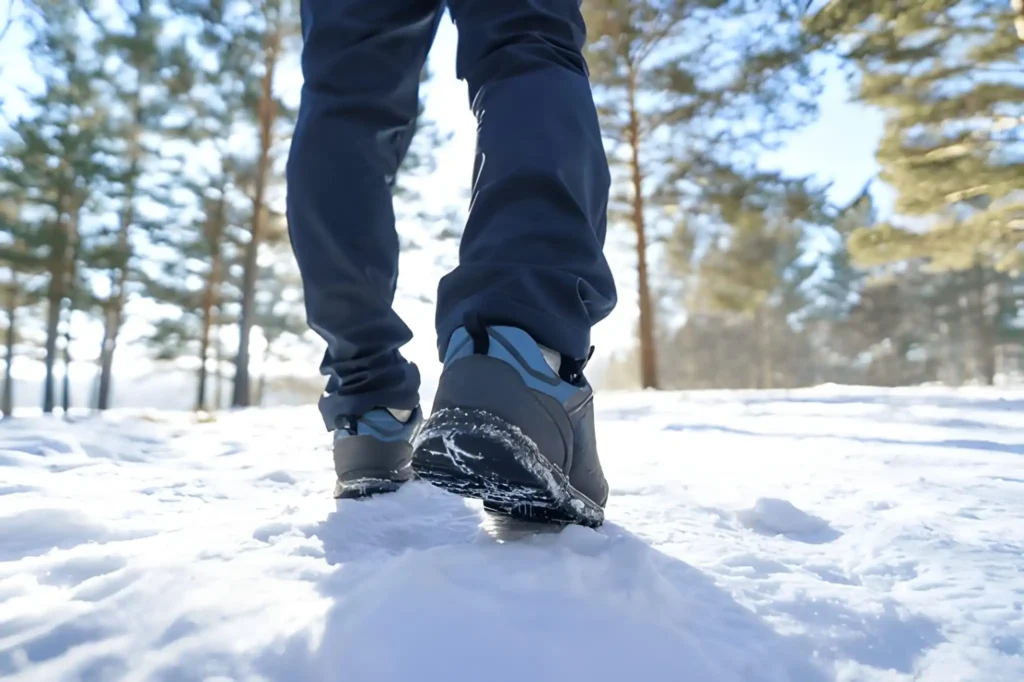
Conclusion
Choosing the Best hiking boots is one of the most important steps for any hiker. The right pair keeps your feet protected, gives you the support you need, and makes every mile on the trail more enjoyable. In our testing of more than 50 different models, we focused on comfort, durability, traction, weight, and water resistance. From that process, we selected the nine best hiking boots for men in 2025.
If you want all-around performance at a fair price, the NORTIV 8 Men’s Insulated Waterproof Hiking Boots are our top overall choice. For budget-friendly comfort, the Merrell Moab 3 Mid Waterproof is a proven classic. For heavy backpacking, the Salomon Quest 4 Gore Tex provides unmatched support. Climbers can trust the Scarpa Zodiac Plus GTX, while hikers who explore off-trail will appreciate the La Sportiva Ultra Raptor II Mid GTX. Wide-foot hikers will find comfort in the KEEN Targhee IV WP, and casual day hikers will enjoy the lightweight feel of the KEEN Hightrail Mid. For maximum waterproof protection, the La Sportiva Nucleo High II GTX is hard to beat.
No matter your hiking style, there is a boot on this list that will match your needs. By thinking about where you hike, how long you go out, and what kind of support your feet need, you can pick the pair that will keep you safe and comfortable for years to come.
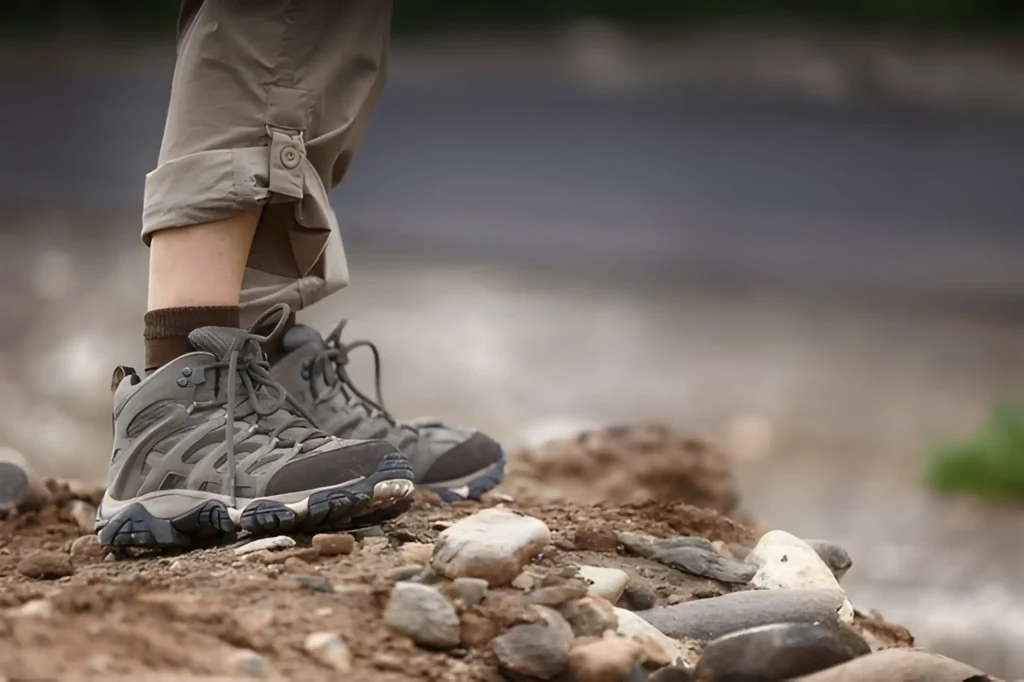
FAQs
Q: What is the most comfortable hiking boot for men?
The Merrell Moab 3 Mid Waterproof is one of the most comfortable boots available because it offers soft cushioning and supportive midsoles right from the first wear. It does not require a long break-in period like many leather boots. The roomy fit and breathable mesh lining also add to its comfort on warm days. While other boots like the Salomon Quest 4 give more stability, the Moab 3 is a favorite for casual and long day hikes where comfort is the top priority.
Q: Are waterproof hiking boots worth it?
Yes, waterproof hiking boots are worth it if you often hike in wet conditions. Boots with Gore Tex membranes or other waterproof linings keep feet dry when walking through rain, puddles, or wet grass. This helps prevent blisters and keeps your feet warmer in cold weather. However, waterproof boots can be less breathable in hot climates, so hikers in dry areas may prefer lightweight non-waterproof options for better airflow.
Q: What is the difference between hiking boots and hiking shoes?
Hiking boots are taller, usually covering the ankle, and are designed for long hikes, backpacking, and rough terrain. They provide strong ankle support and better stability when carrying heavy packs. Hiking shoes are shorter and lighter, making them easier to wear on short hikes or smooth trails. Shoes are more flexible and breathable, but do not protect the ankles as well. Choosing between boots and shoes depends on how tough your hikes are and how much support you need.
Q: How long do hiking boots last?
A good pair of hiking boots can last between 500 and 1000 miles of hiking. The lifespan depends on how often you hike, the type of terrain, and how well you take care of the boots. Leather boots usually last longer because they resist wear and can be reconditioned with treatments. Synthetic boots are lighter and dry faster, but often wear out faster, especially around the seams and soles. Regular cleaning and drying your boots properly after wet hikes will help them last longer.
Q: Which hiking boots are best for wide feet?
The KEEN Targhee IV WP is one of the best choices for hikers with wide feet. KEEN is known for its roomy toe boxes, which reduce pressure on the front of the foot and make long hikes more comfortable. These boots still offer good ankle support and durable waterproofing, so you do not have to trade fit for performance. Some other brands also offer wide sizes, but KEEN is the most trusted option for naturally wide feet.
Q: Should hiking boots be tight or loose?
Hiking boots should fit snug but not tight. The heel should stay firmly in place without sliding up and down, which prevents blisters. The ankle should feel supported, but the boot should not squeeze so much that it cuts off circulation. In the toe box, there should be enough room to wiggle your toes and prevent pressure on descents.

